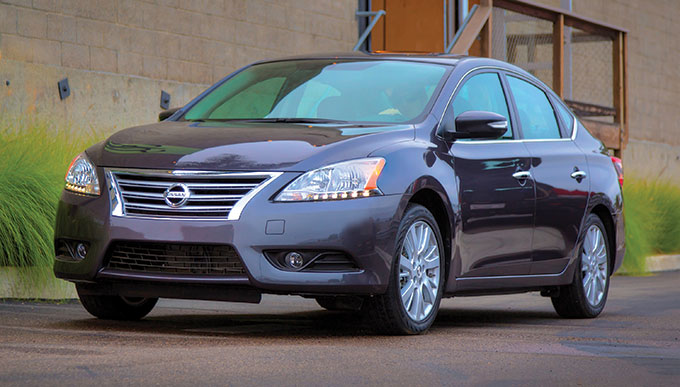Honey, I Shrunk the Altima
by Jim Corbran

2013 Nissan Sentra
Just how much does the new Nissan Sentra look like the almost-as-new Altima? In the back lot of Mike Barney Nissan, in a row filled with some of each, I got into a new Altima instead and didn’t even realize it right away until I reached for the seat adjuster and realized that what should have been a manual handle was a power button. Oops. That’s not to take anything away from the Altima; rather, I think, “Kudos to the Sentra designers.” Thanks to Steve Michaels for showing me around.
The Sentra, of course, is Nissan’s entry in the crowded compact field, where it’s competing with the likes of the Toyota Corolla, Ford Focus, Chevy Cruze, and Hyundai Elantra. The Sentra made its debut for the 1982 model year, where it replaced the Datsun 210, during Nissan’s transformation away from the Datsun name, which was used only in North America. The new 2013 Sentra is the model’s seventh generation, a huge improvement over the rather bland model sold from 2007 to 2012. Nissan has managed not only to make it look more upscale than it is but to make it lighter while increasing it in size.
Getting into the new Sentra (eventually), I was impressed with the interior space. Reaching down and finally finding that manual seat adjuster, I moved the driver’s seat all the way back and was barely able to reach the pedals. So most anybody taller than my six feet should still be able to fit comfortably, as the head room is also very adequate. Moving the front seat to a more manageable position still left plenty of leg room for rear seat passengers, and rear head room was also okay. Three can fit back there, but only if they’re on the thin side—most adults will be more comfortable if there’s only two of them.
The Sentra pricing starts at $15,990 for the base, or S, model; moving on up, there’s the rather awkwardly named FE+ S at $17,720 (which includes the CVT transmission and a host of gas-saving features), followed by the more up-scale SV ($18,030) and FE+ SV ($18,430) models, and finally the sporty SR ($18,930) and the premium SL at $19,820. All Sentras come with Nissan’s 1.8-liter four-cylinder engine (EPA-rated 30/39 miles per gallon city/highway with the CVT—the manual transmission is available only in the base model). SR and SL models come with 17-inch aluminum spoked wheels; the others have standard wheel covers. Standard sound system is an AM/FM/CD audio system, with four speakers on the S models, and six on all others. If you’re wondering what almost four grand gets you, moving up from the base to the SL, here are some highlights, besides what I’ve already mentioned: Smart Auto headlights and fog lights; heated outside mirrors with LED turn signals; push-button ignition; Sirius/XM radio; USB connection port; dual-zone automatic temperature control; leather-wrapped steering wheel; maple wood-tone interior trim; and more.
Over the years, the Sentra has been many cars to many people: two- and four-door sedans, three-door hatchbacks, and station wagons. There have also been forgettable rental car-like iterations (we had one for a California vacation back in 1989) and the sporty SE-R Spec V (zero to 60 in under seven seconds) from the early 2000s. This time around, Nissan is sticking to four-door sedans throughout the Sentra range, which seems to be what the American car-buying public wants. With all the choices out there, even though the Sentra is a capable car, Nissan might need a bit more to make themselves noticeable, as the competition has been around for a while. That being said, the Sentra certainly deserves a look.
More info at nissanusa.com.
Read more of Jim Corbran's You Auto Know every other week in Artvoice, and more frequently on Artvoice Daily.
blog comments powered by Disqus|
Issue Navigation> Issue Index > v12n16 (Week of Thursday, April 18) > Honey, I Shrunk the Altima This Week's Issue • Artvoice Daily • Artvoice TV • Events Calendar • Classifieds |









 Current Issue
Current Issue